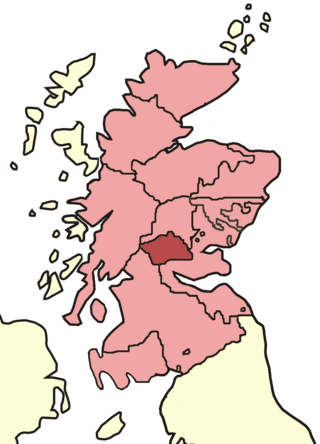
Crieff is a Scottish market town in Perth and Kinross on the A85 road between Perth and Crianlarich, and the A822 between Greenloaning and Aberfeldy. The A822 joins the A823 to Dunfermline. Crieff has become a hub for tourism, famous for whisky and its history of cattle droving. Attractions include the Caithness Glass Visitor Centre and Glenturret Distillery. The nearby Innerpeffray Library is Scotland's oldest lending library. St Mary's Chapel beside it dates from 1508. Both are open to the public: the library is run by a charitable trust; the chapel is in the care of Historic Scotland.

Lake of Menteith, also known as Loch Inchmahome, is a loch in Scotland located on the Carse of Stirling.

The Gask Ridge is the modern name given to an early series of fortifications, built by the Romans in Scotland, close to the Highland Line. Modern excavation and interpretation has been pioneered by the Roman Gask Project, with Birgitta Hoffmann and David Woolliscroft. The ridge fortifications: forts, fortlets and watchtowers were only in operation for a few years, probably less than ten.

Carolina Oliphant, Lady Nairne – also known as Carolina Baroness Nairn in the peerage of Scotland and Baroness Keith in that of the United Kingdom – was a Scottish songwriter. Many of her songs, such as, "Will ye no' come back again?", "Charlie is my Darling", "The Rowan Tree" and "Wi' a Hundred Pipers' remain popular today, almost two hundred years after they were written. One of her songs, "Caller Herrin'", was sung at the 2021 commemoration of the 1881 Eyemouth disaster. She usually set her words to traditional Scottish folk melodies, but sometimes contributed her own music.

Lord Oliphant was a title in the Peerage of Scotland. It was created twice and de facto under Peerage Law a third time. The first creation is in abeyance of the law, the second extinct and the third creation is dormant.

Laurence Oliphant (1691–1767) was a Jacobite army officer who belonged to a branch settled at Findo Gask in Perthshire, Scotland. He took part in the Jacobite rising of 1715, and both he and his son Laurence were actively concerned in the rising of 1745. Oliphant senior served as Governor of Perth during the advance to Derby and both were present at the battles of Falkirk and Culloden.
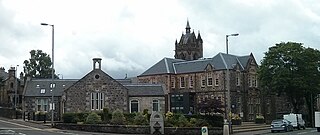
Kilmacolm is a village and civil parish in the Inverclyde council area, and the historic county of Renfrewshire in the west central Lowlands of Scotland. It lies on the northern slope of the Gryffe Valley, 7+1⁄2 miles southeast of Greenock and around 15 miles (24 km) west of the city of Glasgow. The village has a population of around 4,000 and is part of a wider civil parish which covers a large rural hinterland of 15,000 hectares containing within it the smaller settlement of Quarrier's Village, originally established as a 19th-century residential orphans' home.

Kilmahog is a hamlet situated half a mile to the west of Callander, Scotland.

Methven is a large village in the Scottish region of Perth and Kinross, on the A85 road due west of the town of Perth. It is near the village of Almondbank. The village has its own primary school, church, bowling club, community halls, playing field with sports facilities and skate-park, and a variety of businesses.

Clan Oliphant is a Highland Scottish clan.
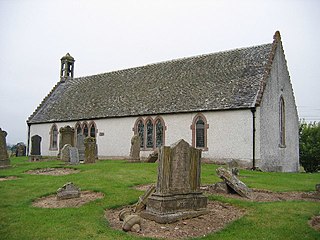
Madderty is a village in Strathearn, Perth and Kinross. It lies on the former railway line connecting Perth and Crieff. The Gask Ridge and its Roman road lie to the south and the remains of Inchaffray Abbey to the north.

Inchaffray Abbey was situated by the village of Madderty, midway between Perth and Crieff in Strathearn, Scotland. The only traces now visible are an earth mound and some walls on rising ground which once formed an island where the abbey once stood.
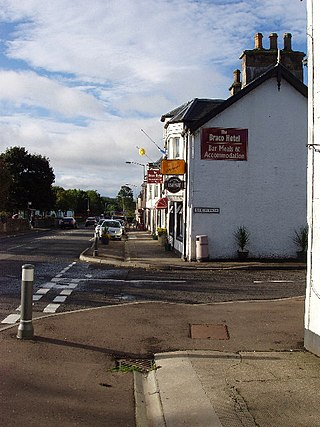
Braco is a village in Perth and Kinross, Scotland, with a population of 515. It is located 5 miles north of Dunblane towards Perth off the A9 road.
Findo Gask were an electropop band from Glasgow, Scotland, comprising Gerard Black, Michael Marshall, Gregory Williams and Gavin Thomson.

George Hay, 7th Earl of ErrollPC was a Scottish nobleman and politician.
Laurence Oliphant, 8th of Condie and 30th Chief of Clan Oliphant, was the member of the United Kingdom Parliament for Perth between 1832 and 1837. He was a Liberal and his strong views on reform caused controversy.

Mumrills was the site of the largest Roman fort on the Antonine Wall in Scotland. It is possible that Mumrills could exchange signals with Flavian Gask Ridge forts. Some believe Mumrills may have been the site of Wallace's defeat at the Battle of Falkirk. The farm at Mumrills was also used as an early site for the Falkirk Relief Church.

Drumquhassle was a Roman fort associated with the Gask Ridge in Scotland. It was found from aerial photography in the late 1970s. The name selected for the fort deliberately made it hard for English born readers to pronounce. The fort was from the Flavian period; it was built and briefly occupied by during the administration of Sallustius Lucullus. It is known as a "Glen-blocker" fort and is located within sight of Loch Lomond.
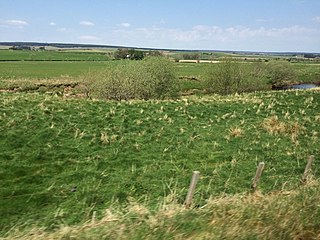
Glenbank was the site of a Roman fortlet associated with the Gask Ridge in Scotland. It was discovered from aerial photography by G. S. Maxwell in 1983. It was confirmed by geophysics and excavations which were carried out in 1984 and 1999. It is beside the Roman road that linked the forts at Ardoch and Doune. It is currently the most southerly of the known Gask fortifications. It was probably built around 70-80 AD. Several other Gask installations have been identified running north to Bertha.














